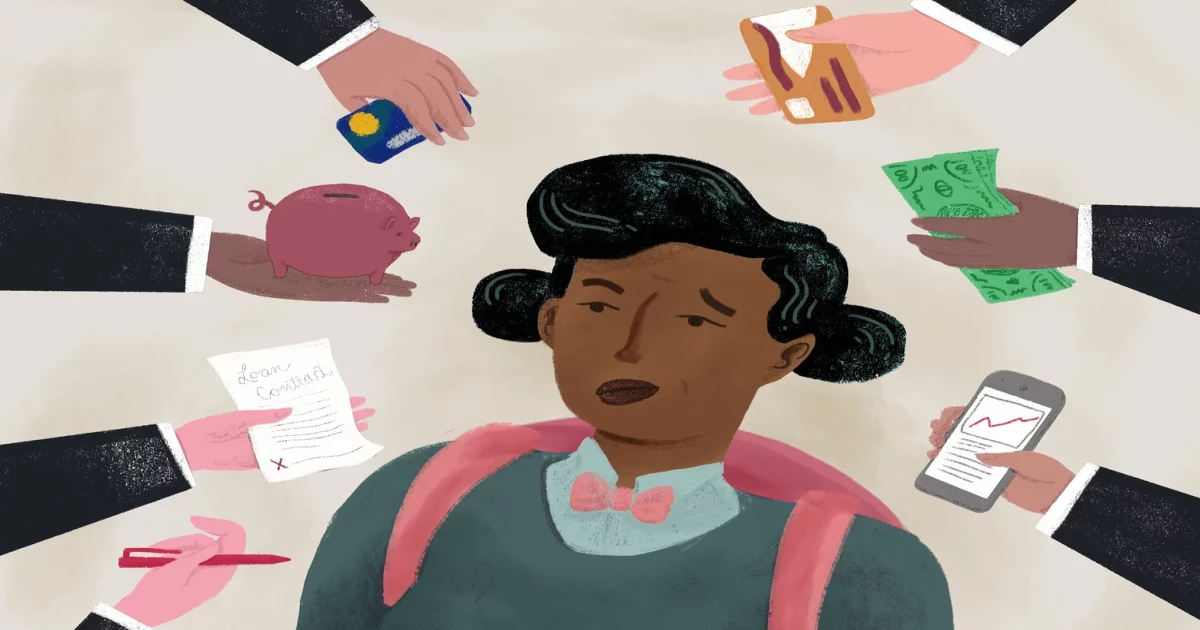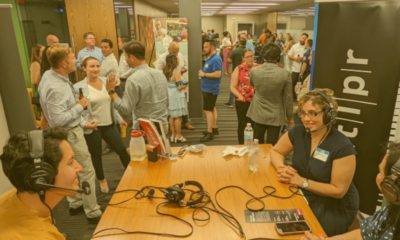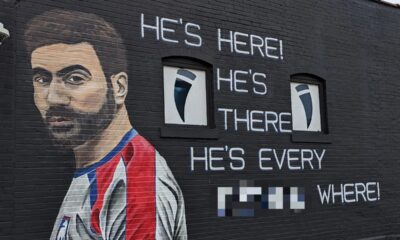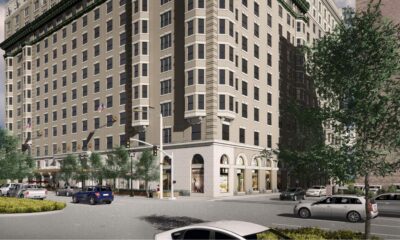Business
A St. Louis nonprofit will open Afghan business support centers next year

The International Institute of St. Louis will open an Afghan Community Center and a national Afghan Chamber of Commerce in south St. Louis in February to help Afghans maintain their identity and learn entrepreneurship skills. Afghans can take Farsi and English language classes and attend public speaking events and after-school programs and workshops to help them thrive while living in the region. The chamber will offer Afghans business training and financial literacy classes that will help promote entrepreneurship.The new business programs and classes could help Afghans build community and businesses in St. Louis, said Moji Sidiqi, the institute’s Afghan Community Support program manager.“The chamber of commerce is going to build opportunities for financial growth,” Sidiqi said. “That’s really going to take the trajectory of the Afghan economic state to another level.”The new community center will sit inside the old Hispanic Chamber of Commerce of Metropolitan St. Louis building off South Grand Avenue near Gravois Park. The chamber of commerce will operate from within the center.Over the past year, the institute helped resettle more than 700 Afghans who fled Afghanistan because they feared for their lives as the Taliban took control of their home country.Some of those Afghans who come to St. Louis have entrepreneurial backgrounds and want to start businesses in their new home city, said institute CEO and President Arrey Obenson.“They came here as refugees … [and] are now taxpayers. They are now employees,” Obenson said. “They are now in many cases, entrepreneurs, many of them are doing DoorDash and Uber. So they are really already significantly adding to the economic prosperity of the community.”Obenson hopes the community center and the chamber of commerce will encourage other Afghans to move to St. Louis to take advantage of the resources and add to the region’s economy.So far, 131 Afghans have moved to the region from other cities across the nation.“Hopefully, we see many of them setting up businesses with the help that they would get from the resources developed by the Afghan Chamber of Commerce that should eventually lead to economic growth,” Obenson said.The chamber of commerce also will offer entrepreneurship and skills training courses to women, including sewing and cooking classes to inspire Afghan women to start clothing companies or restaurants.Being a woman entrepreneur is typically not encouraged in Afghan culture. Hopefully the programs inspire Afghan women to gain business acumen, Sidiqi said.“We are taking a demographic of people, and putting them in their own space where they can connect with their own identity, but also thrive in a new city, which is their new home,” she said.
Business
Recovery center to give vacant north St. Louis school new life
A former St. Louis Public Schools building in north St. Louis that’s been vacant for two decades is now set to get new life as an addiction treatment and recovery center.The roughly $22.7 million rehabilitation of the old Eliot School by Jubilee Community Development Corp. will establish the Jubilee Wellness Center, with room for 75 beds to help those recovering from substance use disorder.“Everybody is affected by the fentanyl epidemic,” said Andy Krumsieg, administrative pastor of Jubilee Community Church. “It hits every family. Almost all of us know somebody that has been addicted [to opioids].”Krumsieg said he sees many people in the neighborhoods around Jubilee Community Church, located at 4231 N. Grand Blvd., contend with the challenges of substance use, mental illness or homelessness. Sometimes it’s a combination of all three, he added.“They have no place to go,” he said, adding that means many often seek refuge in vacant or abandoned buildings or sleep in the open.
Brian Munoz
/
St. Louis Public RadioAndy Krumsieg, administrative pastor at Jubilee Community Church, speaks about the rehabilitation of the historic Eliot School on April 25 in St. Louis’ Fairgrounds neighborhood. The roughly $22.7 million rehabilitation of the old school by Jubilee Community Development Corp. will establish the Jubilee Wellness Center, a center with 75 beds to help those recovering from substance use disorder.
But the new wellness center, once completed, will offer a place to kickstart recovery from addiction in a region that only has a handful of detox beds, Krumsieg said.“We won’t be an official detox center, but we’ll do 90% of what a detox center will do,” he said. “We just don’t have the medical level of what is happening in a detox center.”The development project marries desperately needed addiction recovery services with the revitalization of the one of the first school buildings designed by prolific St. Louis architect William B. Ittner, said Joel Fuoss, principal at Trivers, the architect firm on this project.“To do this in a new building, it would be successful from their programming,” he said. “But metaphorically it wouldn’t quite resonate the same.”The school, built in 1898, has sat empty since 2004. Jubilee Community Development Corp. acquired the building in July 2022, according to city records.The building’s exterior hides those two decades of vacancy well; the wear over that time becomes more apparent on the inside.
Brian Munoz
/
St. Louis Public RadioA second-floor classroom in Eliot School on April 25 in St. Louis’ Fairgrounds neighborhood. Debris and graffiti are left behind from the decades this building sat vacant.
Small pieces of rubble blanket the floors, betraying any nearby footsteps, and tiny cracks ripple through the old lead paint peeling away from the walls it used to cover. Immense and intricate graffiti stamps the insides of different cavernous rooms.But just beneath these surface layers is a building that’s remarkably solid for its century and a quarter age. Fuoss notes there’s hardly any evidence that the building is in need of stabilization.“The building is sitting on the bedrock, which is why you don’t see a lot of settlement,” he said. “The bones [and] the core are strong — a lot of things you could say about north St. Louis. The core is there, it needs a lot of the other attention, and a lot of that’s doable. It just takes some work and some money.”
Brian Munoz
/
St. Louis Public RadioJoel Fuoss, principal at the St. Louis-based Trivers architecture firm, on April 25 at the historic Eliot School in St. Louis’ Fairgrounds neighborhood. Trivers is the architecture firm working on this $22.7 million revitalization.
The symbolism of the project to restore a beautiful and prominent building is not lost on Fuoss.“What it says to restore some of your architectural treasures is imperative to [what] it says to the rest of the community,” he said. “For that to be ignored and to just let it go to waste also has a statement too.”Already some eight to 10 40-yard dumpsters of debris have been removed from the building, Krumsieg said. While walking through, he points out different elements waiting to be restored, like an old Tuskegee Airmen mural and some of the original flooring.
Brian Munoz
/
St. Louis Public RadioThe Eliot School on April 25 in St. Louis’ Fairgrounds neighborhood. Jubilee Community Development Corp. has plans to restore some of the old murals in the building.
Krumsieg expects construction will take 12 to 15 months to complete, but there’s still the challenge of getting all of the funding together for the project. St. Louis’ Community Development Administration has already allocated money to the project and could award more in the future.The project will also apply for New Markets Tax Credits, Historic Tax Credits and congressional appropriation, Krumsieg said. He said the amount of financing from those sources will determine what kind of fundraising is needed.“We welcome partnership from anywhere and everywhere, but nobody is coming to save us, and we have to have our skin in the game,” he said. “And we do.”Krumsieg added it’s no different from many of the other projects the church has taken on in recent decades, including an organic farm, launching a lawn care and landscaping business, managing hundreds of apartments and establishing addiction recovery homes.“Virtually everything we’ve taken on, we didn’t have the resources to do it,” he said. “But we knew we should do it and we went forward knowing that things would come together.”This new facility will extend the addiction treatment and recovery services Jubilee already provides by offering a place of employment for those who are moving through the program, Krumsieg said.This is a critical part of the church’s approach to addiction recovery, which has helped hundreds of people, said Bryan Moore, senior pastor at Jubilee Community Church.
Brian Munoz
/
St. Louis Public RadioThe gym inside Eliot School on April 25 in St. Louis’ Fairgrounds neighborhood. This space will be revitalized into a multipurpose use at the Jubilee Wellness Center.
Ample examples of success telegraph hope and a starting point for those who need help, and Moore said many of the men who go through Jubilee’s recovery program become leaders in it and can help guide others to recovery with an intimate understanding of that challenge.“It’s very important for us to have these success stories because any time a man comes in and he’s saved, he goes back out there and gets five or 10 other men,” he said.The new facility in the revitalized school will house the first phases of recovery, while the final phases will shift to the roughly 45 existing beds Jubilee already has across four recovery homes, Moore said.He admits the church’s recent success in responding to addiction in the community came after years of too many community members dying from opioid overdoses in the north St. Louis neighborhoods that surround Jubilee.“I was losing men that looked up to me, that respected me and who called me pastor,” Moore said. “We literally, not figuratively, stepped over bodies of men that we were responsible for.”Moore calls this “the price of ignorance,” in responding to a struggle that he and his church saw frequently but in ways that weren’t effective, he said.“Being overly spiritual about a very practical condition,” Moore said.The COVID-19 pandemic shutdowns offered Moore and the leaders at Jubilee time and space to reflect and determine if their programs to help north St. Louisans suffering from substance use were working, he said. Moore also took note of the number of churches concentrated in north city and questioned if his organization was really benefiting the community.“Maybe there’s so many sick people because there’s so many churches that had overpromised and underdelivered, and were ill equipped to handle the true measure of the problem,” he said.
Brian Munoz
/
St. Louis Public RadioThe Eliot School on April 25 in St. Louis’ Fairgrounds neighborhood. The revitalization of the school included removing a partition in this room.
Coming out of the pandemic, Moore said he and his church resolved to address addiction and the root causes of it in the community differently than before. In 2021, they welcomed a mobile clinic from the Assisted Recovery Center of America and in 2022, built out a physical space for the addiction recovery provider, Moore said.“We realized [people with substance use disorder were] coming through the door, instead of just feeding [them], let’s treat [them],” he said. “Because [they] were coming through the door constantly.”Krumsieg said the addiction recovery programming shifted to focusing first on the way addiction affects someone’s physical body and mind.“Oftentimes as Christians we have tried to do the theology part as the foundation,” he said. “While it is the foundation, it can’t be the first thing you work on.”Moore explained their partnership with ARCA helps get those in the community dependent on substances access to Naltrexone (also known as Vivitrol), an opioid antagonist that binds to the opioid receptors in the brain without activating them.“You can’t get high if you wanted to,” he said. “You can OD, but you can’t get high.”It provides the time and space for Moore and leaders in the church’s addiction recovery program, many of whom he said were once dependent on opioids themselves, to help others address the trauma that may have contributed to the addiction over time. Then they can pay it forward.“Most of the men who go through this program, they don’t leave,” he said. “They become stakeholders in the community. They become invested in the community and watch out for the other men.”
Business
Economic insecurity and depression are high among young adults

Every generation has the sense that what it’s faced has been unique. People born between 1999 and 2005, however, can rightly claim they’ve lived through a great deal already. As the Federal Reserve Bank of St. Louis’ 2024 State of Economic Equity report points out, that swath of young people has already lived through recent instances of historic economic precarity: the COVID-19 recession (aka the Great Lockdown), and high inflation plus “the tightest labor market since World War II.”Ana Hernandez Kent is a senior researcher who’s part of the Institute of Economic Equity team behind the St. Louis Fed report. She told St. Louis on the Air those phenomena have contributed to a troubling number of “disconnected” 18-24 year olds who’re not working or in school, and comparatively high rates of depression.“They’re not acquiring retirement savings. They’re not acquiring savings to save for a house, a downpayment, or even future education. It’s concerning because they’re not potentially building for their future financial stability,” Kent said. “Depression isn’t just an isolated mental condition… it has an impact on the economy if they are perhaps staying out of either education or having a job because they’re depressed,” Kent continued. “Or if they have a job, we know depression and other mental illnesses are more likely to [cause] people to have lower productivity, to take days off. So [mental health] has a wider, broad spread economic impact.”The 2024 report also shows disparities by race in how secure young adults feel about their financial well being. While about 75% of white and Asian young adults said they felt they were doing “at least OK financially,” just over 50% of Black and Hispanic young adults reported the same. Kent said capacity to handle a $400 emergency expense illustrates how that disparity can show up in everyday life.“If you go to the emergency room and you don’t have health insurance, that’s going to blow that [$400] out of the water, and I have a car repair that’s needed, that’s likely going to be more than that. The fact that so many young adults – especially Black and Latino young adults – said they would be unable to handle this kind of expense, that’s very concerning.”Kent said it’s important to focus on 18-24 year olds because young adults are important to the economy at large.“If we’re not supporting these young adults, particularly by race, ethnicity, by gender — companies are missing out on a lot of that potential future leadership,” she said. “They’re not going to be building retirement savings, they’re not going to be building savings to be able to pay a down payment on a house…. So the economy as a whole is not gaining from that, leaving economic potential on the table.”To hear more about how factors like race and gender affect young people’s actual and perceived economic security and what practical support can do to help disconnected young folks gain stability, listen to St. Louis on the Air on Apple Podcast or Spotify, or click the play button below.
Many young adults face economic insecurity and depression, finds new St. Louis Fed report
“St. Louis on the Air” brings you the stories of St. Louis and the people who live, work and create in our region. The show is produced by Ulaa Kuziez, Miya Norfleet, Emily Woodbury, Danny Wicentowski, Elaine Cha and Alex Heuer. Roshae Hemmings is our production assistant. Our audio engineer is Aaron Doerr.
Business
St. Louis families say they are grateful for $500 monthly checks
Participants in St. Louis’ guaranteed basic income program say they appreciate the safety net the effort has provided.Five of the 540 recipients met Wednesday with Mayor Tishaura Jones and Treasurer Adam Layne to share how they are spending the money and what other resources the city can provide. The program uses $5 million in federal COVID relief funds, plus a $1 million donation from Jack Dorsey to give families $500 monthly checks.To be eligible for the program, families had to live in the city and be the parent or legal guardian of a minor enrolled in a city public or charter school. They could also make no more than 170% of the federal poverty level, which is about $53,000 for a family of four.“We were very specific and intentional about the families we wanted to reach, which were families who were too rich for benefits, but too poor for anything else,” Jones said.The participants can spend the money however they want. One mother who attended the roundtable uses the check to pay for groceries. The funds help another work fewer hours, giving her more time to spend with her daughter, who will be 5 in July.Travious Brooks is using his share to rebuild savings that were wiped out during the COVID-19 pandemic.“My kids are wanting to go on a vacation, so we’re saving up to do that,” he said.He also needs to make repairs to his house, which is more than 120 years old.
Eric Lee
/
St. Louis Public RadioTravious Brooks says he wants to save his money to take his kids on vacation.
All five of the roundtable’s participants said they are glad for the extra help. But they also expressed a need for things like safe transportation for children, more resources for small businesses, and financial literacy classes.“There are a lot of resources in the city, and sometimes they’re not all coordinated,” Layne said. “We’re working on trying to get a resource hub so one place where people can go to our city site, here are all the resources, they’re all connected.”Funding for the program is only available through mid-2025 and Brooks said that was on his mind as he thought about how to use his share.“That was one of the reasons, not knowing the longevity of the program, that I would rather just sit on the funds and have something in the event that anything happened I had something built up,” he said.Jones said she is looking for ways to extend and expand the program.
-

 Entertainment1 year ago
Entertainment1 year agoSt.Louis Man Sounds Just Like Whitley Hewsten, Plans on Performing At The Shayfitz Arena.
-

 Business1 year ago
Business1 year agoWe Live Here Auténtico! | The Hispanic Chamber | Community and Connection Central
-
Board Bills1 year ago
2022-2023 Board Bill 189 — Public Works and Improvement Program at the Airport
-

 Local News1 year ago
Local News1 year agoVIDEO: St. Louis Visitor Has Meltdown on TikTok Over Gunshots
-

 News1 year ago
News1 year agoTed Lasso-inspired pop-up bar now open in St. Louis
-

 Board Bills1 year ago
Board Bills1 year ago2022-2023 Board Bill 165 — Jefferson Arms Community Improvement District
-
Board Bills1 year ago
2022-2023 Board Bill 183 — Amending Ordinance Number 62885 known as the Capital Improvements Sales Tax
-

 News10 months ago
News10 months agoGas tanker crashes into St. Louis Metro transit center





